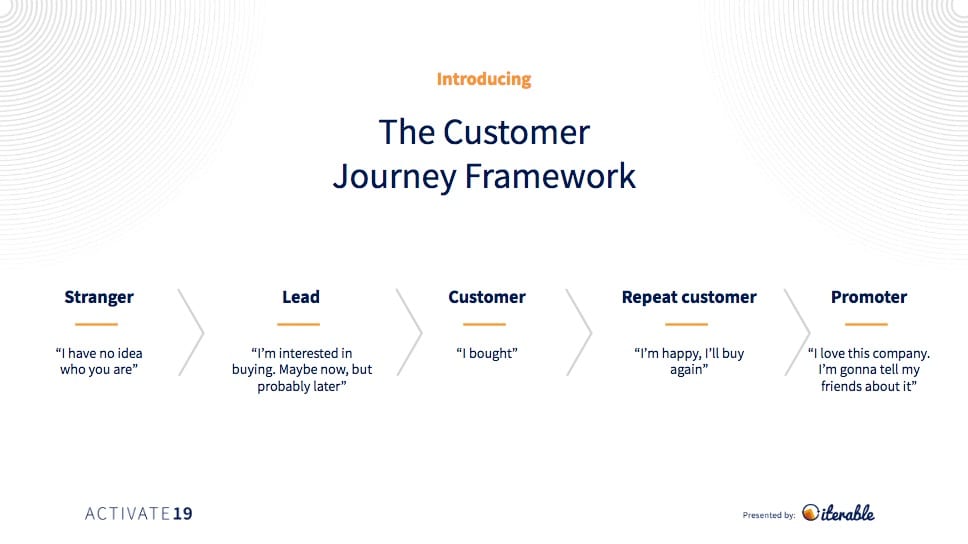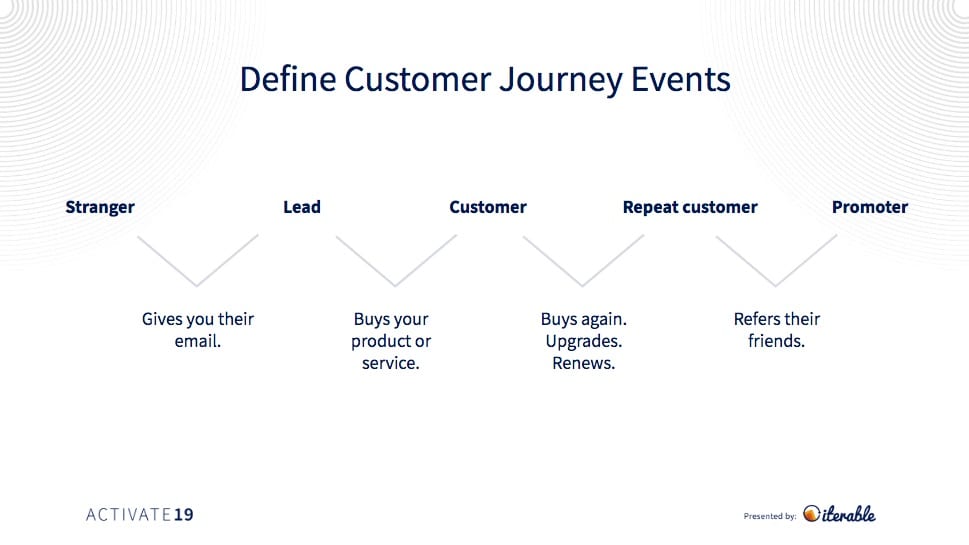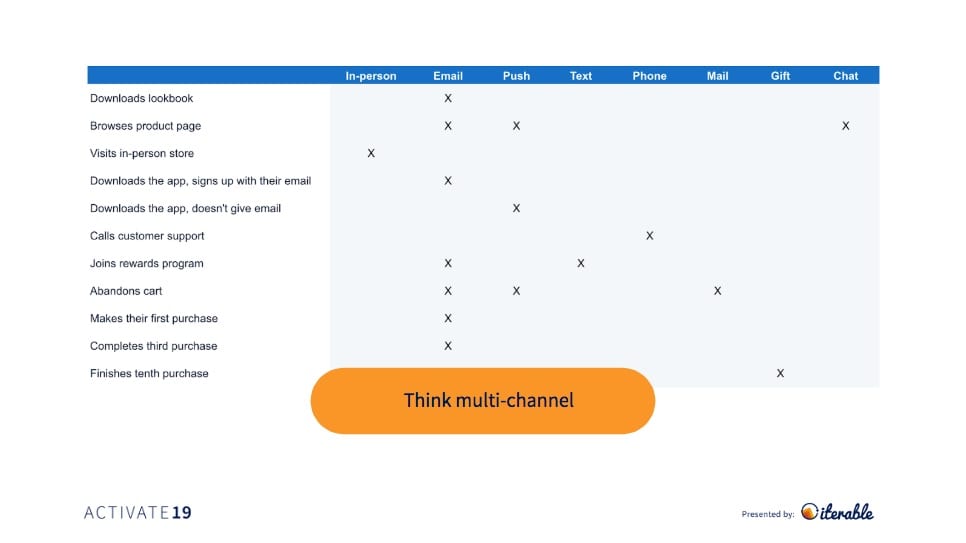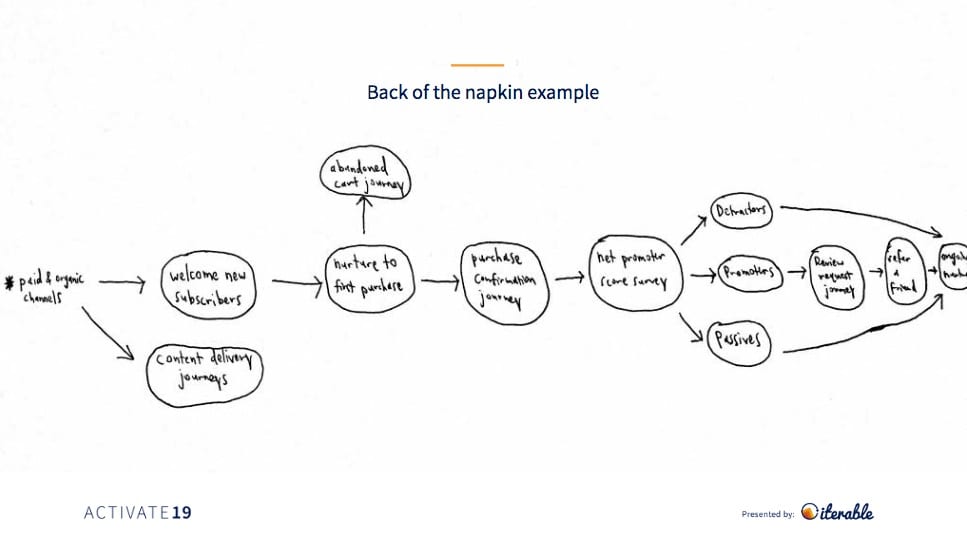If we were to ask you what you thought a “fully automated customer journey” would look like in an ideal state, you’d likely envision something close to what Brian Sun, Lifecycle Marketing Manager at Opendoor dreams of.
Here’s what he pictures: an end-to-end journey where every possible part of the lifecycle and dropoff point is supported by a series of proactive and reactive messages that automatically nudge the customer ever-closer to the next step in their journey. Cross-channel communication happens seamlessly; there are no content gaps, irrelevant messages, or customers slipping through the cracks.
It’s a dream scenario that may seem out of reach, but at Activate 19, Brian did an excellent job of laying out an approachable, 7-step framework to implementing a highly effective marketing automation strategy.
We’ve recapped a small portion of his presentation, but recommend you check out the insight-rich presentation in its entirety!
1. Define the key events in the customer journey
The customer journey encompasses the holistic experience that travels beyond the traditional funnel and instead emphasizes the development of long-term customer relationships.
These journeys can be challenging to map, so Brian recommends breaking the journey into five stages of customer progression: stranger, lead, customer, repeat customer, and promoter.


Breaking down the customer journey into 5 stages helps you assess the needs of your customer at specific times.
Next, drill down a layer deeper and identify the “key events” that need completing before the customer can reasonably advance to the next stage.
The examples listed below are some basic requirements to help you get started, but it’s worth exploring your business-specific nuances to build an exhaustive list—you’ll need this list to drive your marketing automation strategy.


Completion of key events indicates the progression of the customer journey.
Remember, the more steps that people need to complete in their experience with you, the more events you’ll have along your customer journey—the Opendoor journey from stranger to promoter is dozens of events long!
2. Choose the relevant channels for each event
Messages resonate differently on different channels, so you’ll want to strategize how you approach relationships between channel and message content. Get started by identifying all the different communication channels available to your team.
Next, go through your listed key events and ask yourself, “When a person completes X event, what are the best channels to follow up with the person to encourage them to complete the next event?”
For example, you’d ask, “After a person makes their first purchase, what are the best channels to follow up on to get them to their second purchase?” Take note of all applicable channels that align appropriately with the context of each message.


Choose your communication channels wisely by mapping them beforehand.
Think thoughtfully of how you’d like your customers to receive each of these different messages from you. Most of your answers will naturally present themselves as you explore, but carving out the time to map this out in such detail is something most of us haven’t taken the time to do.
3. Create an automation blueprint showing the whole experience
A blueprint is a visual diagram of all of your automated workflows at a glance—whether it’s simple or complex, just putting one together is your first step toward success. In the “back of the napkin” blueprint sketch shown below, you’ll see a sample framework for approaching an automated customer journey.


Even the simplest of workflow mapping will help you see the bigger automation picture more clearly.
Inside this diagram, each circle represents a series of messages, often referred to as workflows in Iterable’s Workflow Studio. For example, “nurture to first purchase” may include a dozen emails, push notifications, and text messages, whereas another circle like “abandoned cart journey” may only include a single email. The point is to see all the workflows for the entire customer experience in one visual.
Remember, it doesn’t need to be perfect; you simply need to start building an initial foundation for you and your teammates to start revising from.
4. Stitch together your marketing stack
Stitching your marketing stack together is all about making sure that data flows seamlessly between each tool. Automation works because certain data signals indicate that specific customers have met the appropriate criteria for certain messages.
Unless you can unite your different customer data sources inside a centralized database, a fully automated journey won’t be possible.
Sit down with your team and list out all the different platforms that comprise your MarTech stack. Identify the types of data the tools are housing—demographic, engagement, CRM, and more—and start mapping out how that data can get into your marketing automation system.
Naturally, this could be a huge project, which may be unrealistic or simply not feasible for a lot of marketers. However, there’s an opportunity to take whatever new data you’ve surfaced in the process to start building workflows that didn’t previously exist.
5. Prioritize the blueprint based on company goals
When you look at your blueprint, you’ll have a natural inclination to construct your entire marketing automation program right now. However, most of us won’t have the bandwidth nor the resources needed for an entire build-out.
The questions you have to ask to prioritize the stages of your build are: “What can add the most value now?” and “What will lead to the biggest impact longer-term?” Walkthrough your planned workflows and categorize them into three different buckets to help you stack-rank the build queue:
- New: Workflows and messages that don’t exist yet.
- Refresh: Workflows and messages that exist, but you want to make better.
- Experiments: Tests you want to run to increase conversion.
Put this all in a doc, spreadsheet, or project management tool and refer back to it as your master to-do list while you build!
6. Build each workflow one-by-one, then rinse & repeat
Start building your workflows by first creating the structure of each campaign. Determine how many messages, the nature of each of them, and then build in the appropriate content and design. Once you have your new messages in hand, it’s time to start tying them together in an automated series.
Word of advice: make the best possible workflow you can at this moment in time. If you’re moving too quickly, you run the risk of delivering subpar campaigns under the guise of, “I’ll fix it later.”
With this in mind, investing the extra energy upfront to key in on quality will ensure a future-state where you’re optimizing for message performance.
7. Launch, learn, and test
Performance metrics matter to any program, and marketing automation is no different. Here are the three layers of metrics to pay attention to:
- Overall program metrics: General campaign metrics, like opens, clicks, unsubscribes, etc., show overall lifecycle health and offer a benchmark for comparison against individual campaign performance.
- Workflow level: These show whether your workflows are moving customers into the next stage of their journey or not.
- Individual message level: These analytics report individual message performance for measuring their effectiveness at driving specific actions.
Opendoor’s Road Toward Marketing Automation With Iterable
An automated customer journey that is designed holistically and rooted in customer respect will enrich the experiences of all customers who go through it, as the marketing team at Opendoor can attest.
With its 7-step framework and robust cross-channel campaign management, Opendoor achieved Iterable’s 2019 Growth Marketing Award for its Most Sophisticated Use of Workflow Studio. With Iterable, automating the entire customer journey is a dream-turned-reality.
Watch the video below to learn how Iterable powers Opendoor’s marketing automation engine, so its team can take their hands off the wheel and dedicate their valuable time to improving the customer experience.
“Depending on the market, almost 50% of our business comes from their repeat offers, and the engine for that is Iterable.” ~ Joey Soriano, Head of Lifecycle Marketing at Opendoor
Interested in learning how Iterable makes all this automation possible? Sign up for a custom demo today!





























